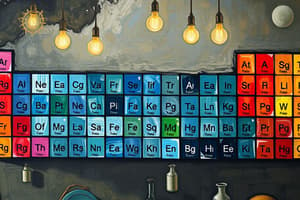Podcast
Questions and Answers
What does the term 'Symbol' refer to?
What does the term 'Symbol' refer to?
- An arrangement of elements by increasing atomic number
- One or two letters that represent the name of an element (correct)
- A group of metals
- A mixture of two or more metals
What is a periodic table?
What is a periodic table?
An arrangement of elements by increasing atomic number
What is an isotope?
What is an isotope?
One of a group of atoms of an element with the same number of protons and electrons but different number of neutrons
Define atomic mass.
Define atomic mass.
What is meant by 'Family' in the context of the periodic table?
What is meant by 'Family' in the context of the periodic table?
What is a metal?
What is a metal?
Define alloy.
Define alloy.
What is a nonmetal?
What is a nonmetal?
What is a noble gas?
What is a noble gas?
Define inert.
Define inert.
Flashcards are hidden until you start studying
Study Notes
Element Classification Terms
-
Symbol: Represents an element using one or two letters, providing a standardized shorthand for chemical identification.
-
Periodic Table: Organized display of chemical elements, sorted by increasing atomic number, showcasing elemental properties and relationships.
-
Isotope: Variation of an element's atoms that share the same number of protons and electrons but differ in neutrons, leading to different mass numbers.
-
Atomic Mass: Calculated average mass of all isotopes of an element, reflecting the relative abundance of each isotope in nature.
Groupings in the Periodic Table
-
Family: A column in the periodic table containing elements that exhibit similar chemical properties and behaviors, facilitating predictable patterns in reactivity.
-
Metal: Typically solid at room temperature (except mercury), these elements are characterized by luster, malleability, ductility, and excellent electrical and thermal conductivity.
-
Alloy: Combination of two or more metals, resulting in materials that often have enhanced properties compared to the individual elements.
-
Nonmetal: Elements that lack the physical and chemical characteristics typical of metals; they may be gases, liquids, or solids at room temperature, and often are poor conductors of heat and electricity.
-
Noble Gas: Group of elements that are inert due to their full outer electron shells; they do not commonly react with other substances, providing stability.
-
Inert: Referring to elements or compounds that do not engage in chemical reactions under standard conditions, emphasizing their lack of reactivity.
Studying That Suits You
Use AI to generate personalized quizzes and flashcards to suit your learning preferences.




